The Daily Shot: 03-Jan-23
• The United States
• The Eurozone
• Europe
• Asia – Pacific
• China
• Emerging Markets
• Commodities
• Energy
• Equities
• Credit
• Rates
• Global Developments
• Food for Thought
The United States
1. The number of states with negative growth is now at the level that signals a recession.
 Source: St. Louis Fed Further reading
Source: St. Louis Fed Further reading
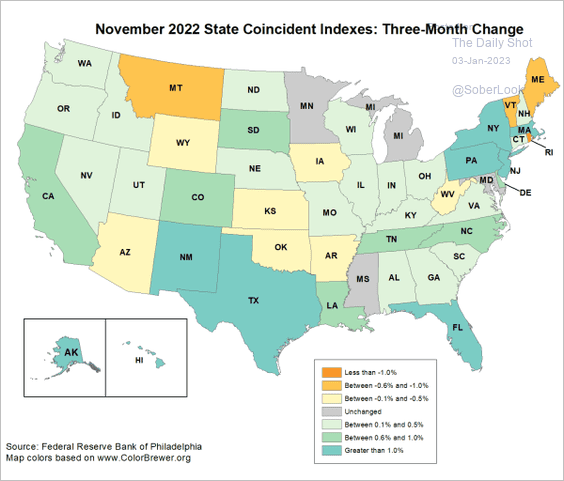 Source: Federal Reserve Bank of Philadelphia
Source: Federal Reserve Bank of Philadelphia
——————–
2. Weak asset prices will be a drag on spending over the next couple of years.
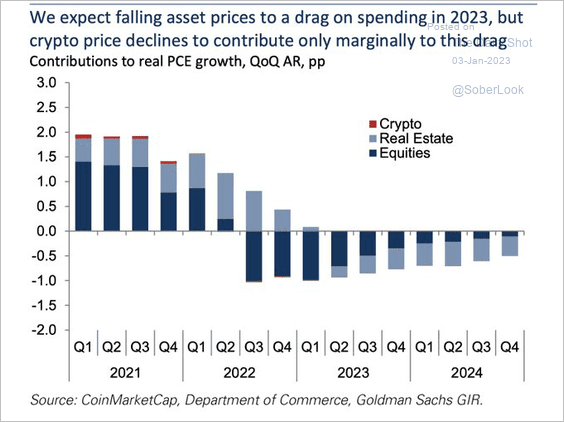 Source: @GoldmanSachs, @acemaxx
Source: @GoldmanSachs, @acemaxx
3. The year-over-year change in US liquidity indicators is now firmly in negative territory.
• Bank deposits:
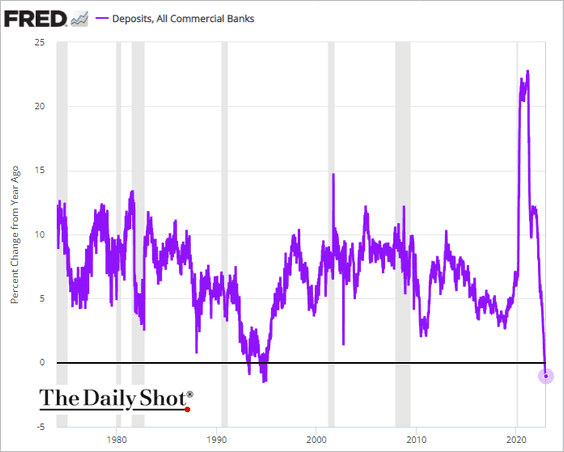
• The broad money supply (M2):
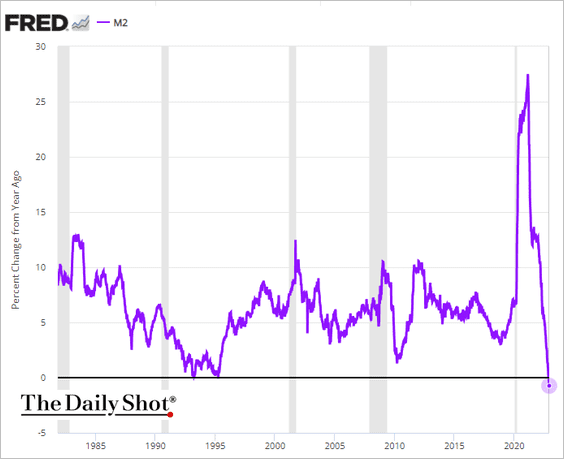
——————–
4. How weak was the nation’s manufacturing demand in December? The ISM report is out tomorrow at 10 AM.
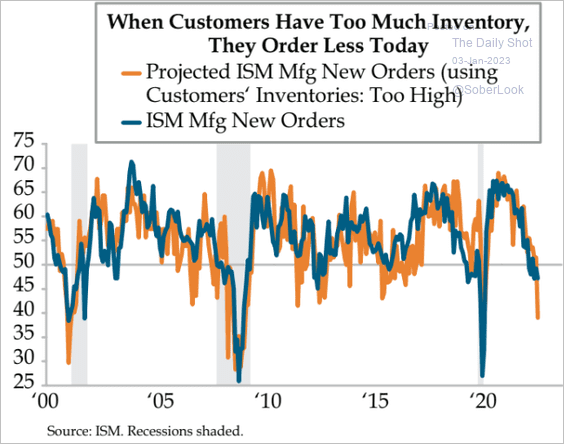 Source: Quill Intelligence
Source: Quill Intelligence
5. Here is why the Fed will keep rates higher for longer.
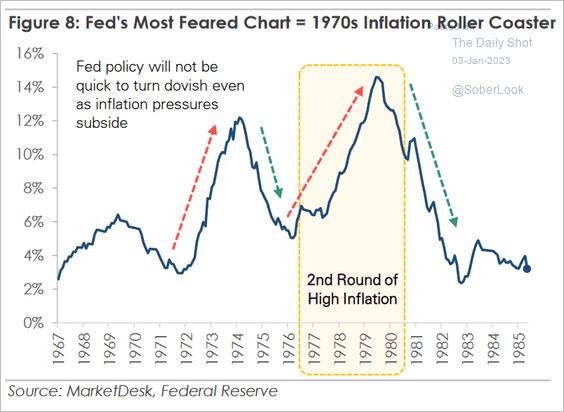 Source: MarketDesk Research
Source: MarketDesk Research
6. Next, we have a couple of updates on the housing market.
• The percentage of floating-rate mortgages has increased, but it is still well below the levels seen prior to the financial crisis.
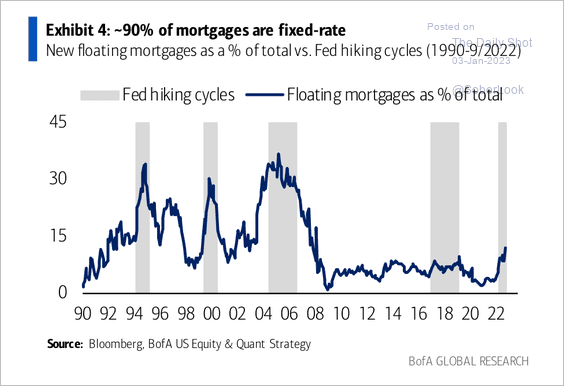 Source: BofA Global Research
Source: BofA Global Research
• New home sales surprised to the upside in November, but the overall decline has been severe relative to previous Fed tightening cycles.
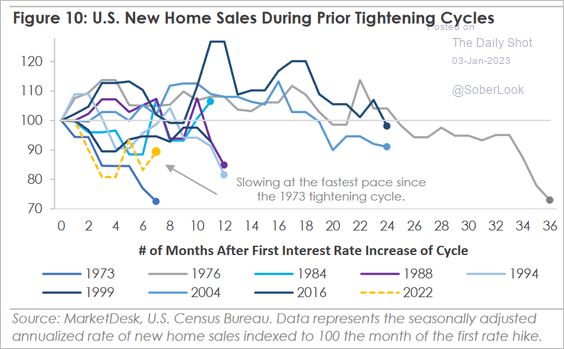 Source: MarketDesk Research
Source: MarketDesk Research
——————–
7. Non-residential construction faces substantial downside risks.
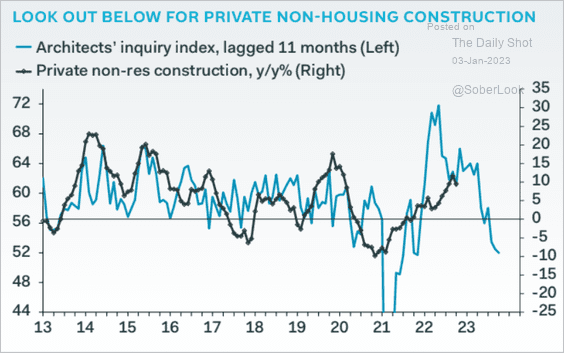 Source: Pantheon Macroeconomics
Source: Pantheon Macroeconomics
Back to Index
The Eurozone
1. While factory activity continues to contract, the pace of declines appears to have slowed a bit.
• Eurozone PMI:
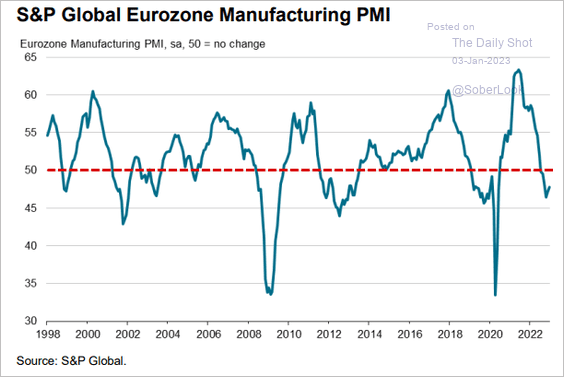 Source: S&P Global PMI
Source: S&P Global PMI
• Italy:
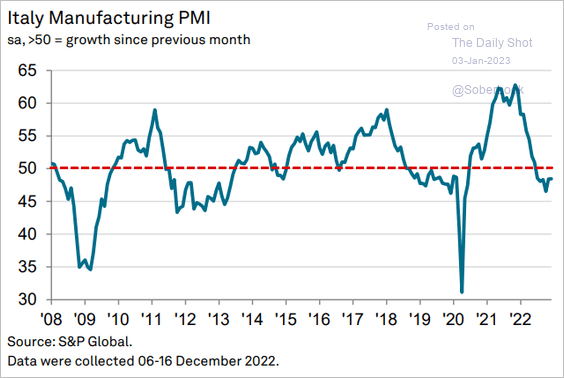 Source: S&P Global PMI
Source: S&P Global PMI
• Spain:
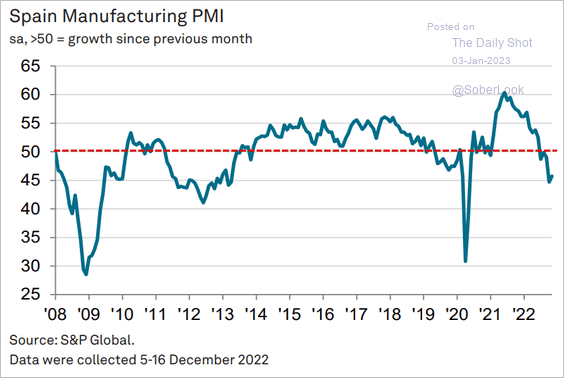 Source: S&P Global PMI
Source: S&P Global PMI
• The Netherlands:
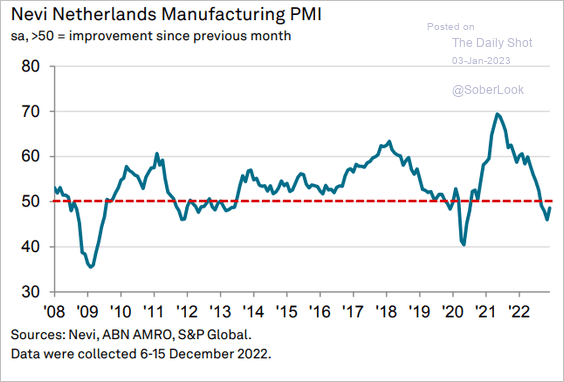 Source: S&P Global PMI
Source: S&P Global PMI
However, the sharp decline in the M1 (narrow) money supply growth points to downside risks for business activity.
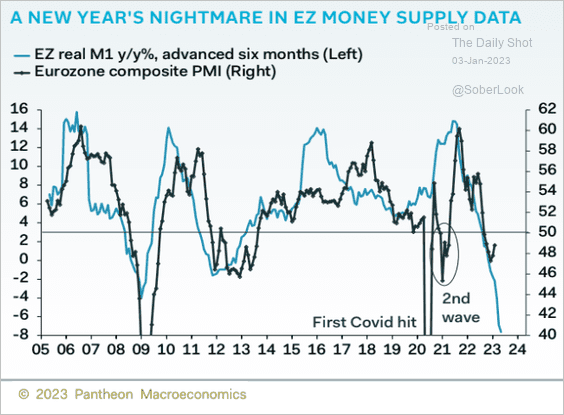 Source: Pantheon Macroeconomics
Source: Pantheon Macroeconomics
——————–
2. Germany’s electricity costs continue to follow natural gas prices lower.
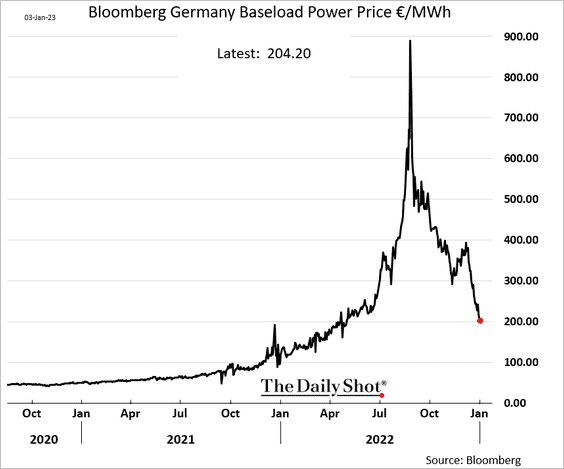
3. Portugal’s consumer confidence remains depressed.
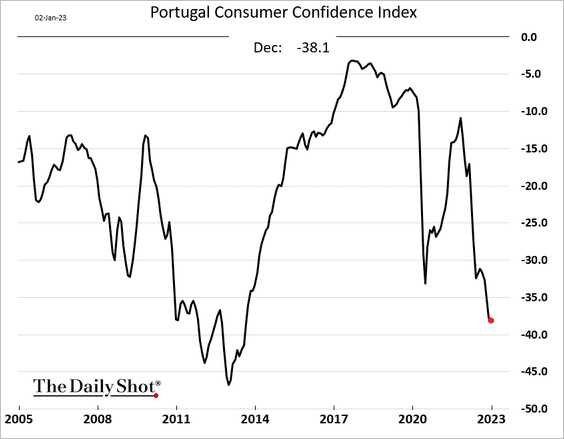
Back to Index
Europe
1. Manufacturing activity in Sweden remains in decline. Price pressures are easing.
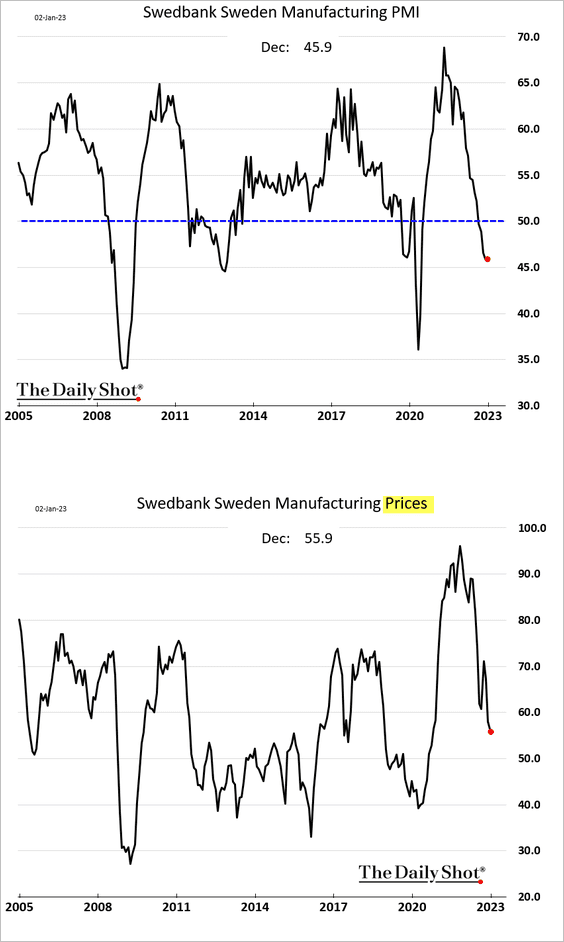
2. Norway’s manufacturing growth has stalled.
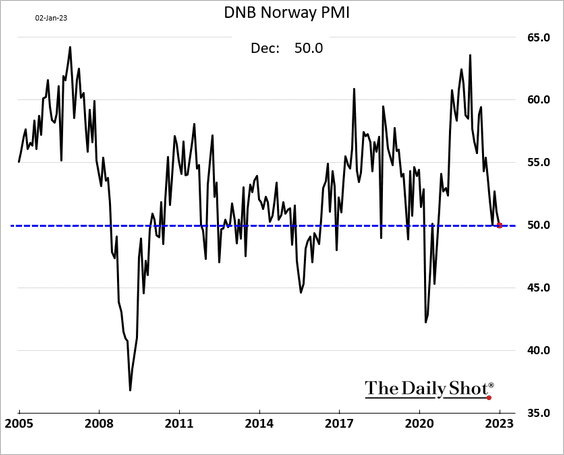
3. Manufacturing PMIs in Poland and the Czech Republic appear to have bottomed but remain deep in contraction territory.
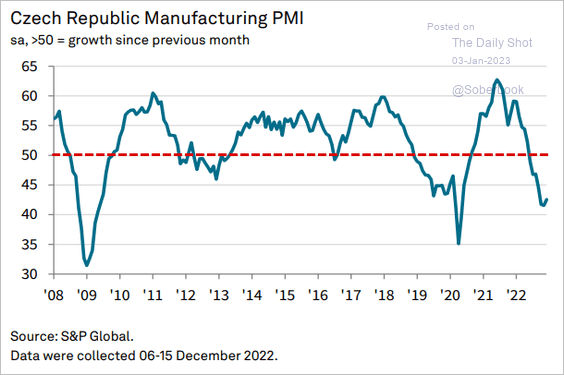 Source: S&P Global PMI
Source: S&P Global PMI
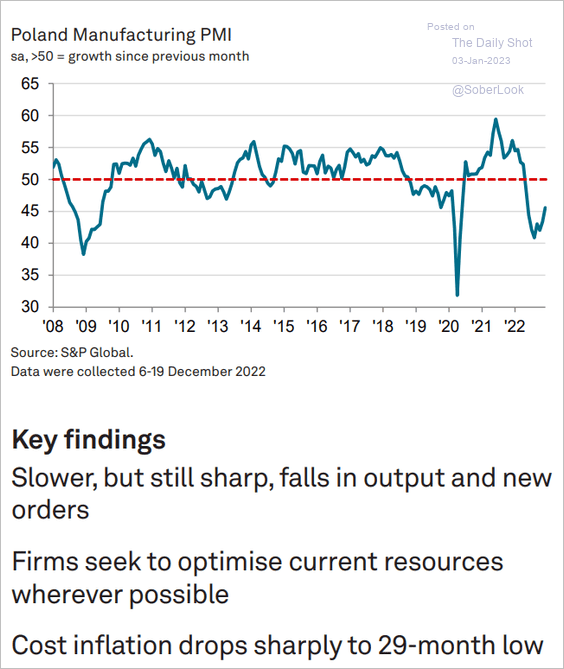 Source: S&P Global PMI
Source: S&P Global PMI
——————–
4. The Swiss 10-year yield hit a multi-year high last week.
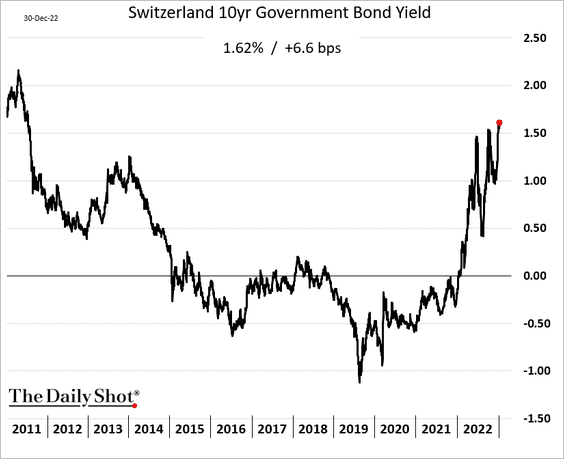
Back to Index
Asia – Pacific
1. Dollar-yen has breached support.
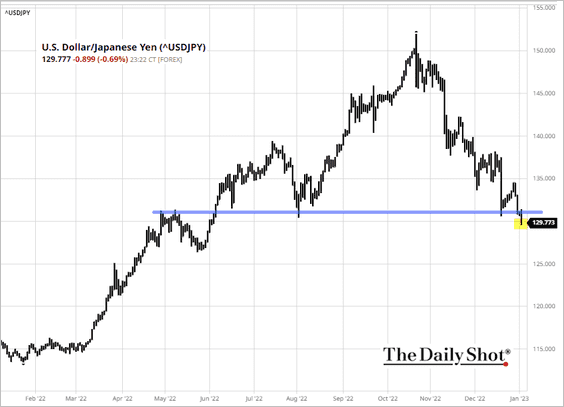 Source: barchart.com
Source: barchart.com
2. Singapore’s economy continues to grow.
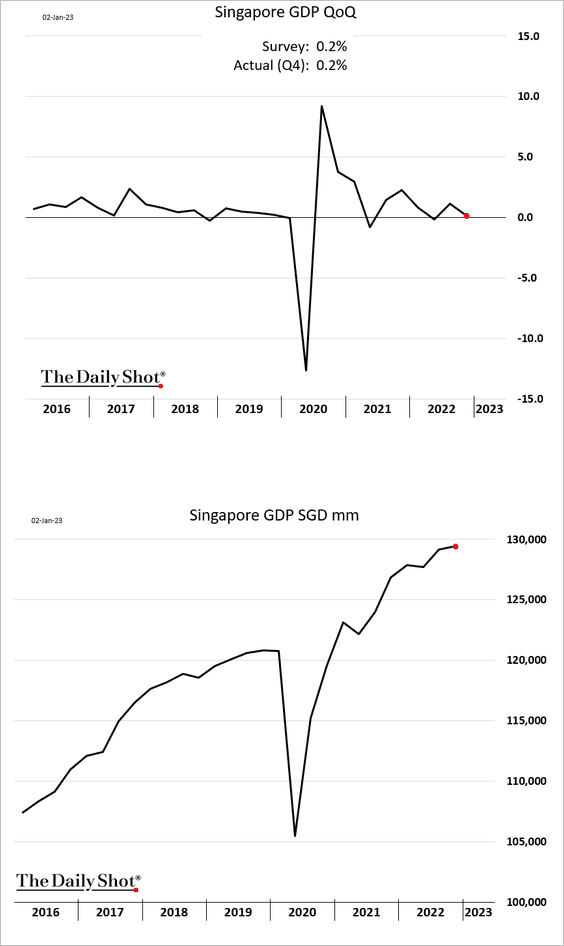
3. The pace of Taiwan’s manufacturing sector contraction has softened.
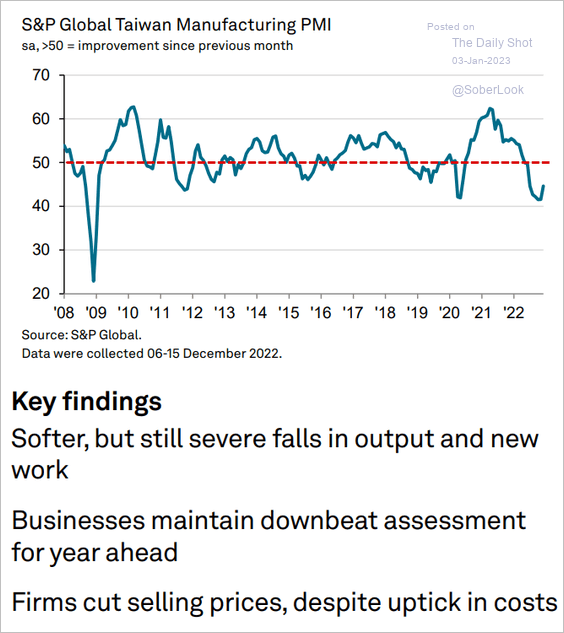 Source: S&P Global PMI
Source: S&P Global PMI
4. Australian manufacturing growth has stalled.
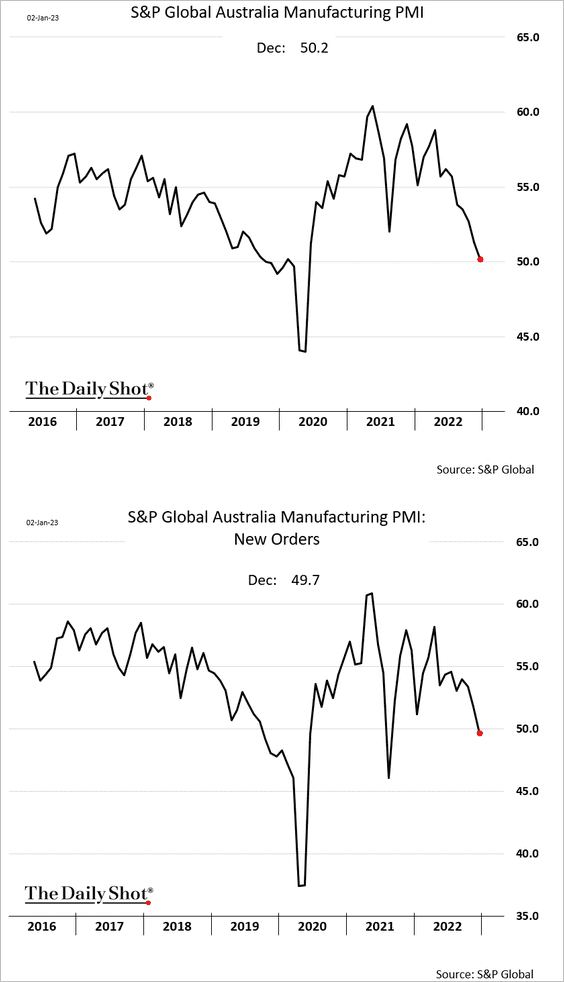
BofA expects a gradual rise in Australian unemployment over the next year.
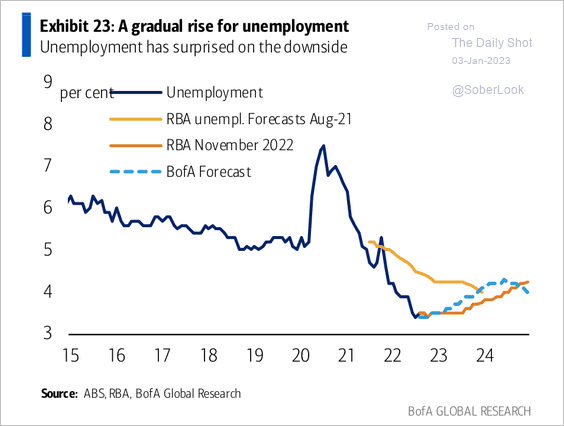 Source: BofA Global Research
Source: BofA Global Research
Back to Index
China
1. The S&P Global Manufacturing PMI confirmed weakness in China’s manufacturing sector.
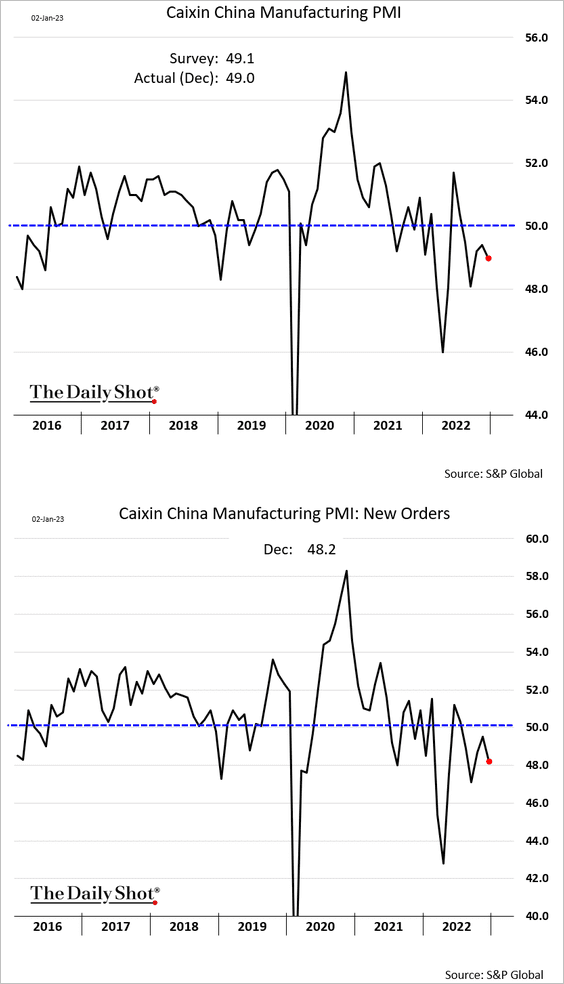
But factories are more optimistic as lockdowns end.
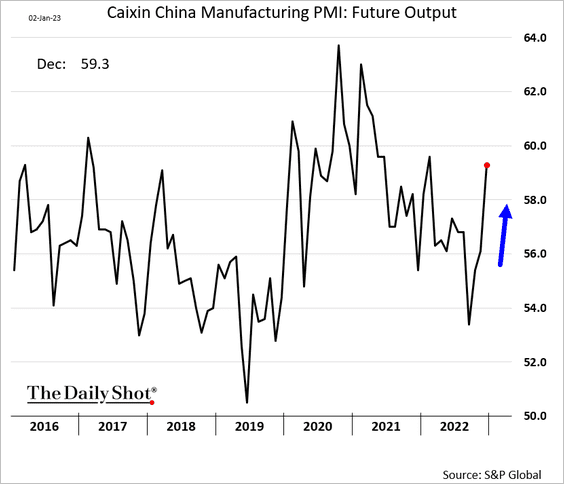
——————–
2. China’s credit impulse turned lower in Q4.
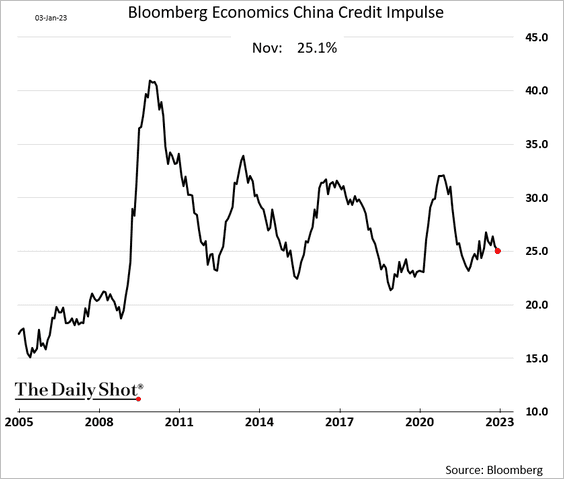
Companies are increasingly tapping “shadow” lenders for credit.
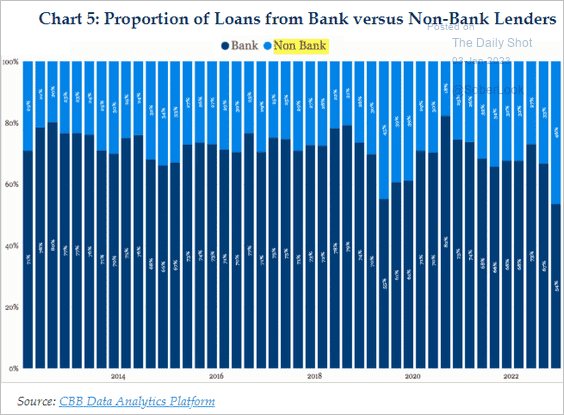 Source: China Beige Book
Source: China Beige Book
——————–
3. Chinese households have accumulated savings during the pandemic. A successful reopening could spur spending and housing demand.
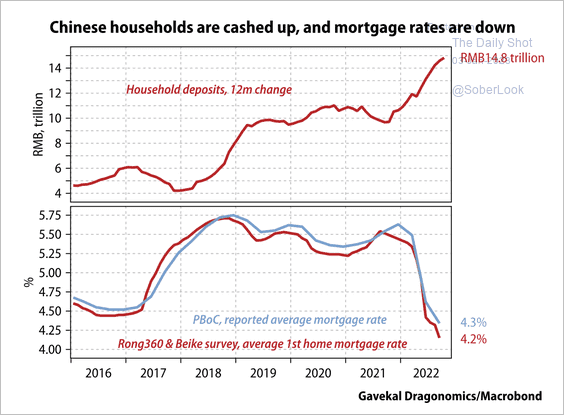 Source: Gavekal Research
Source: Gavekal Research
Dollar-denominated HY bonds (dominated by property developers) are rebounding amid hopes for housing sector stabilization.
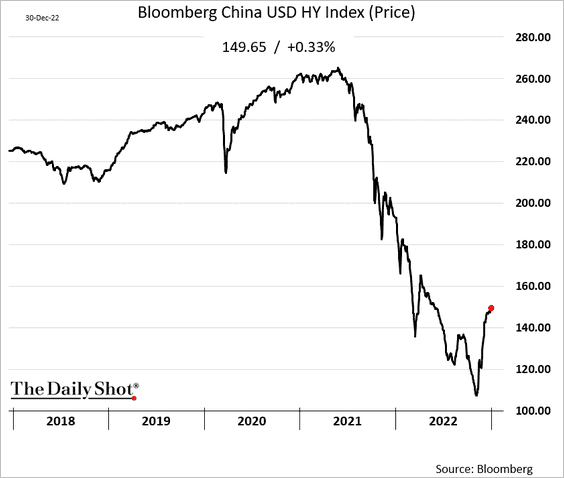
——————–
4. Corporate revenues and margins were under pressure in Q4.
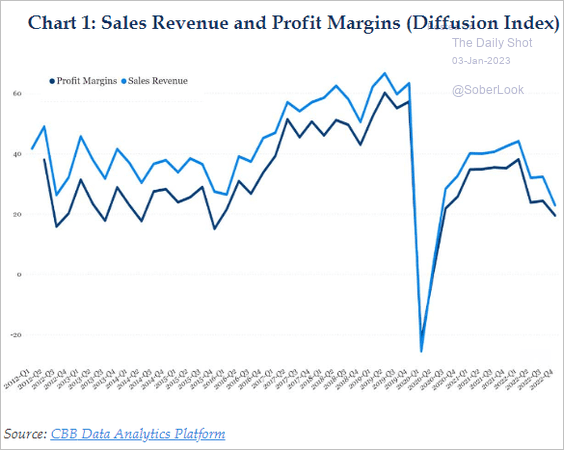 Source: China Beige Book
Source: China Beige Book
5. The US/China yield differential has blown out, driven by diverging monetary policies.
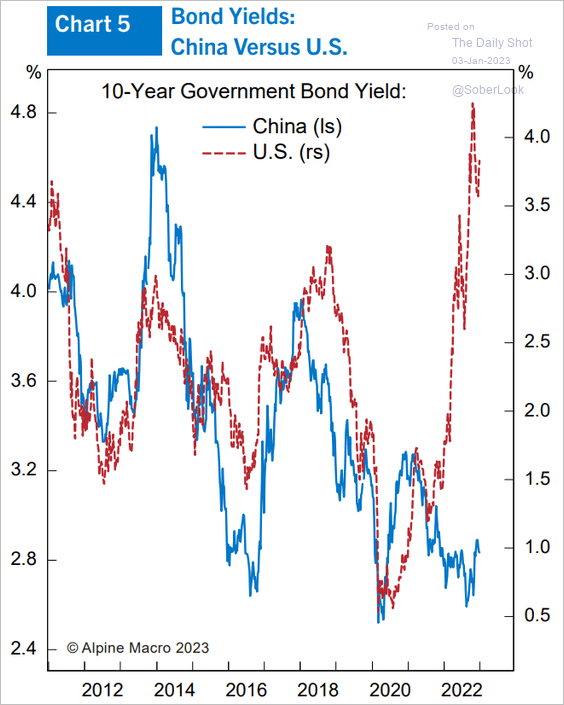 Source: Alpine Macro
Source: Alpine Macro
Back to Index
Emerging Markets
1. Let’s begin with Brazil.
• Stocks tumbled on Monday.
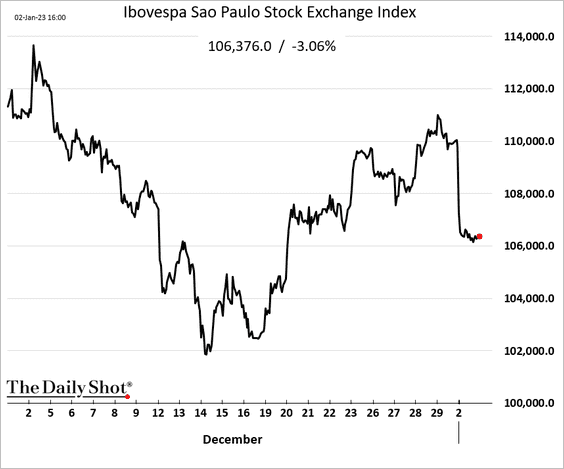
 Source: Reuters Read full article
Source: Reuters Read full article
• The manufacturing sector is in recession.
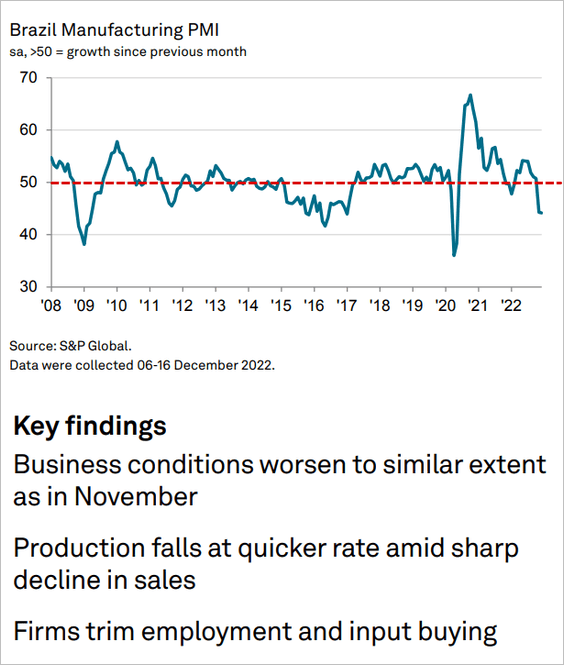
• Credit growth appears to have peaked.
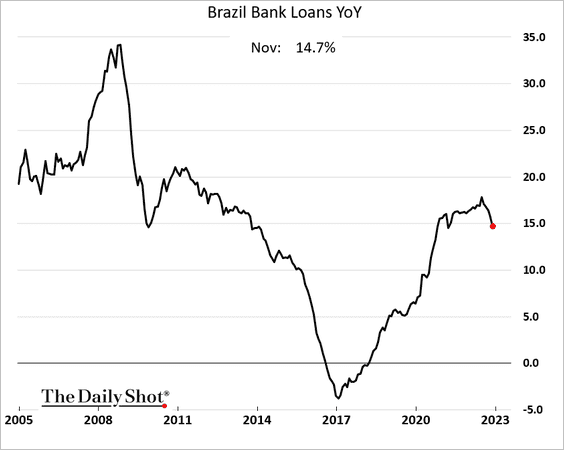
• Consumer confidence remains robust.
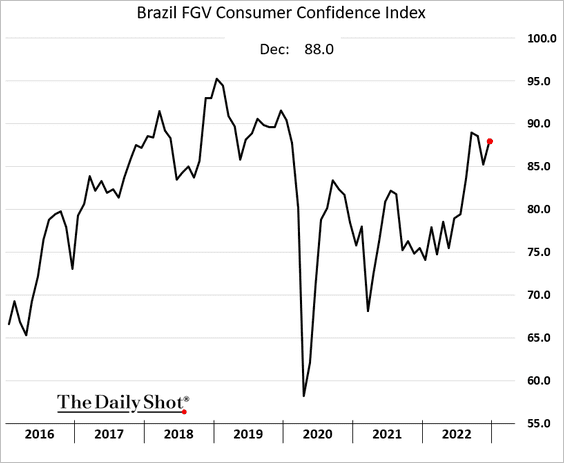
• Job creation has slowed.
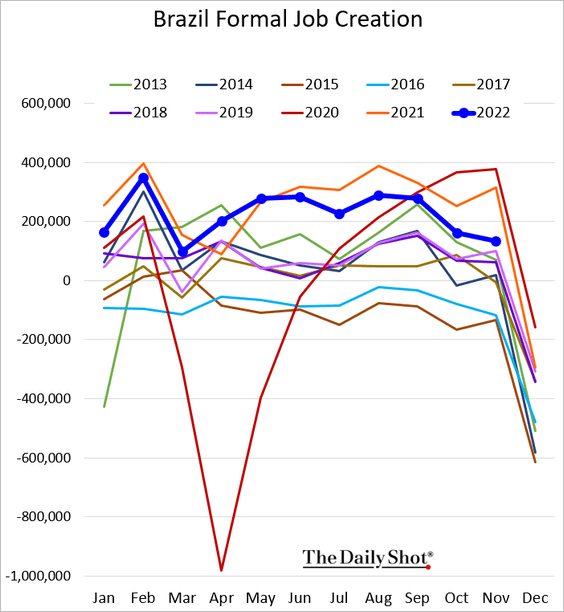
• Inflation continues to ease.
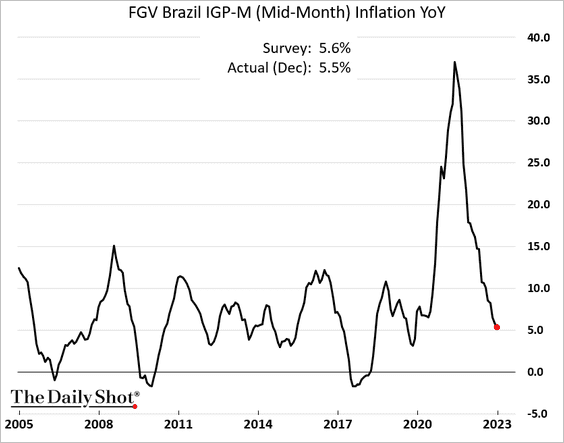
• What do Brazilians see as the key issues Lula should address?
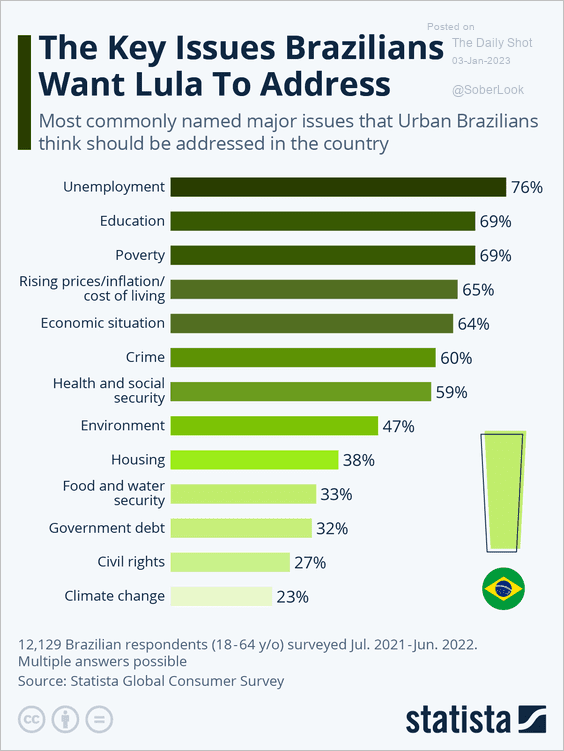 Source: Statista
Source: Statista
——————–
2. Mexican manufacturing growth improved in December.
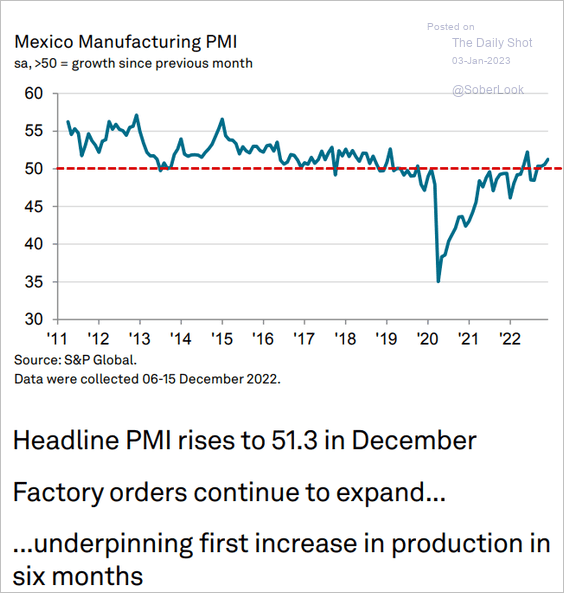 Source: S&P Global PMI
Source: S&P Global PMI
Remittances dropped.
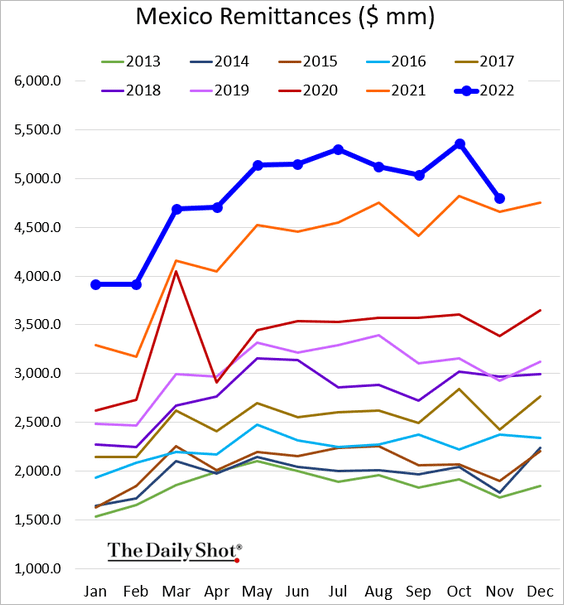
——————–
3. Peru’s inflation remains elevated, fueling unrest.
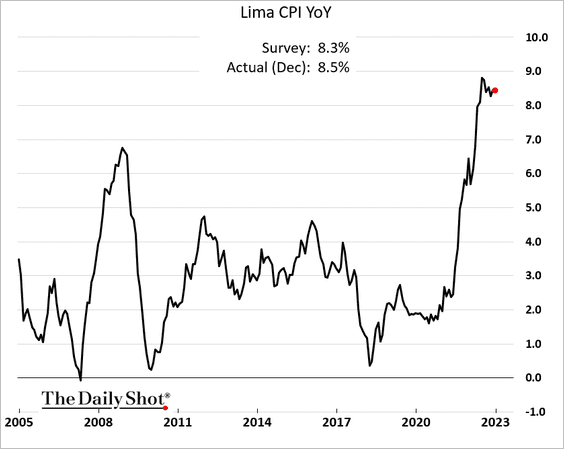
4. The gap between the official and market-based measures of Argentina’s exchange rate has blown out.
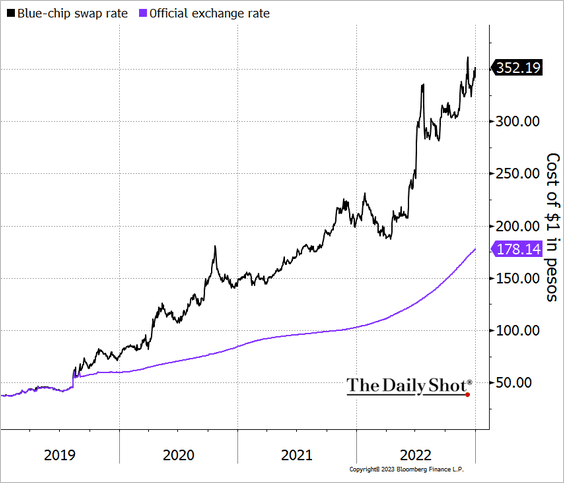 Source: @TheTerminal, Bloomberg Finance L.P.
Source: @TheTerminal, Bloomberg Finance L.P.
5. The synchronized LatAm rate hikes were unprecedented last year.
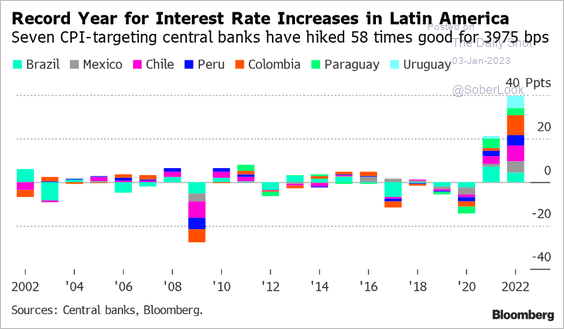 Source: @rhjameson, @TheTerminal, Bloomberg Finance L.P. Read full article
Source: @rhjameson, @TheTerminal, Bloomberg Finance L.P. Read full article
——————–
6. India’s manufacturing growth is surging.
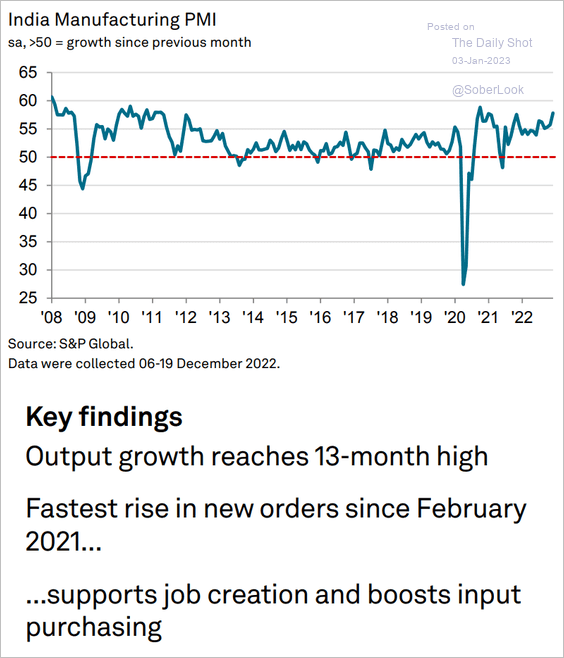 Source: S&P Global PMI
Source: S&P Global PMI
7. The contraction in Vietnam’s factory activity has accelerated, …
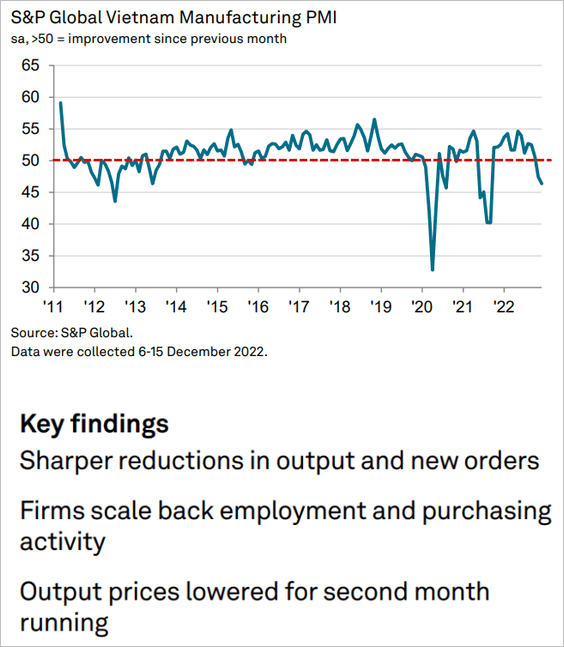
… as exports tumble.
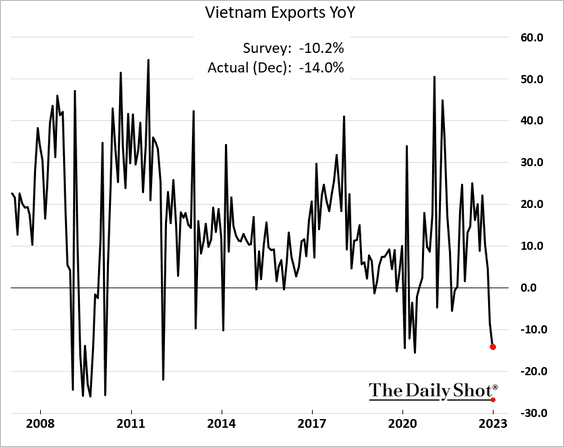
——————–
8. EM equity returns are typically higher than in developed markets 6-12 months after the first Fed rate hike.
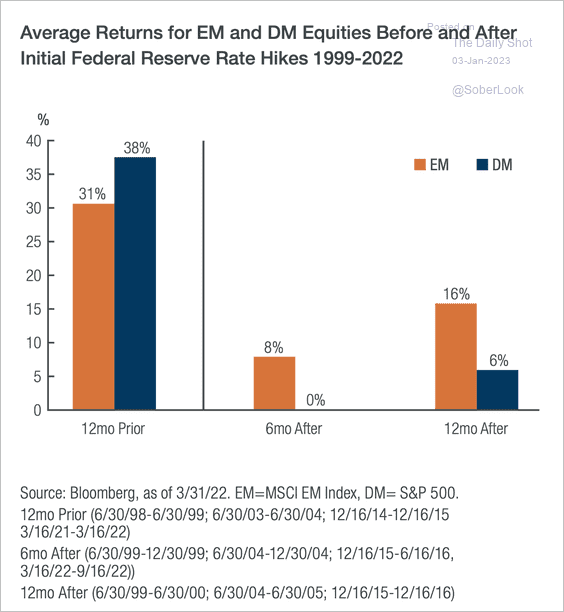 Source: Mirae Asset Read full article
Source: Mirae Asset Read full article
EM previously led global equity rallies after recessions.
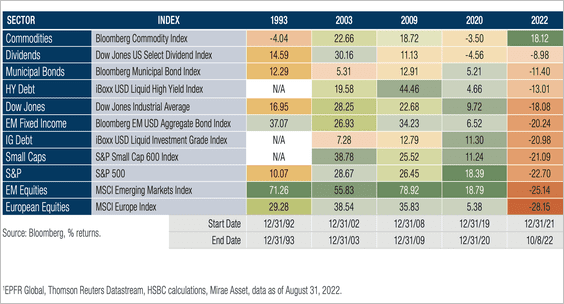 Source: Mirae Asset Read full article
Source: Mirae Asset Read full article
Back to Index
Commodities
1. Commodity prices have risen from significant lows. Could we see further gains?
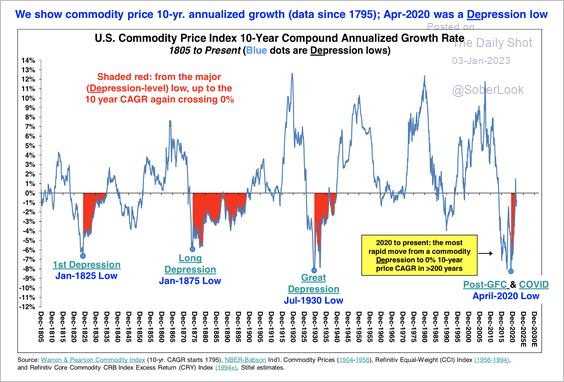 Source: Stifel
Source: Stifel
2. The Thomson Reuters Commodity Index is about 10% away from lower support.
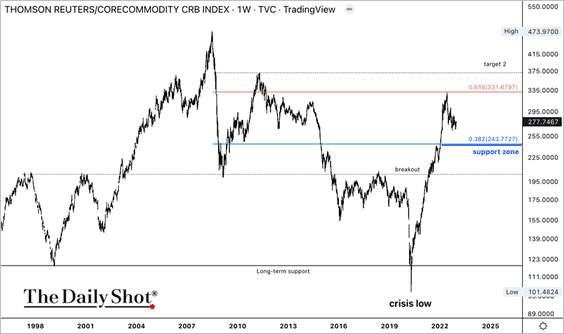
The price ratio of the Thomson Reuters Commodity Index and the S&P 500 is testing support.
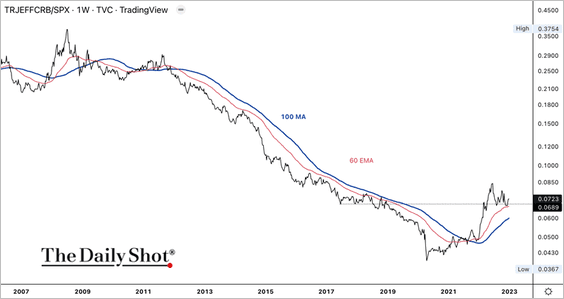
——————–
3. Copper could see further upside as China reopens.
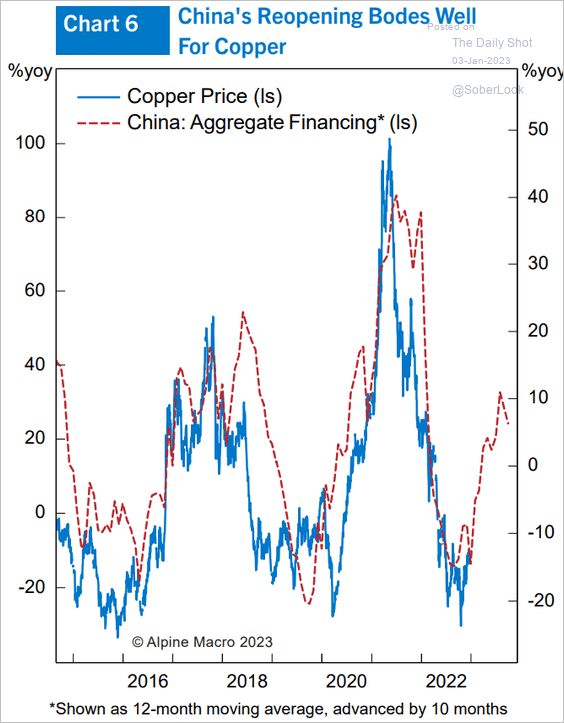 Source: Alpine Macro
Source: Alpine Macro
4. Gold has been (inversely) tied to the US dollar over the past ten months.
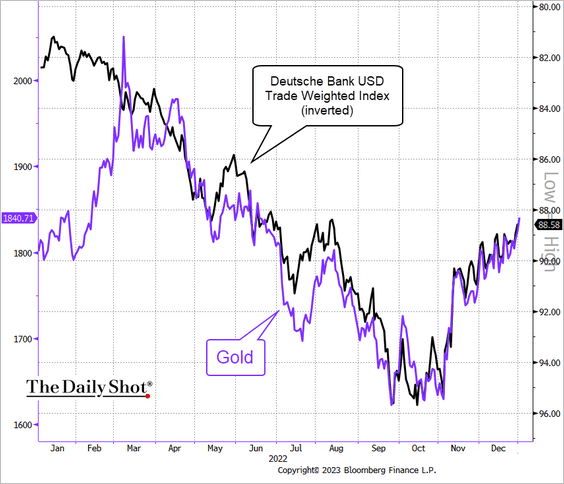 Source: @TheTerminal, Bloomberg Finance L.P.
Source: @TheTerminal, Bloomberg Finance L.P.
Back to Index
Energy
1. US drilled but uncompleted (DUC) wells have risen in terms of weeks of turnover, …
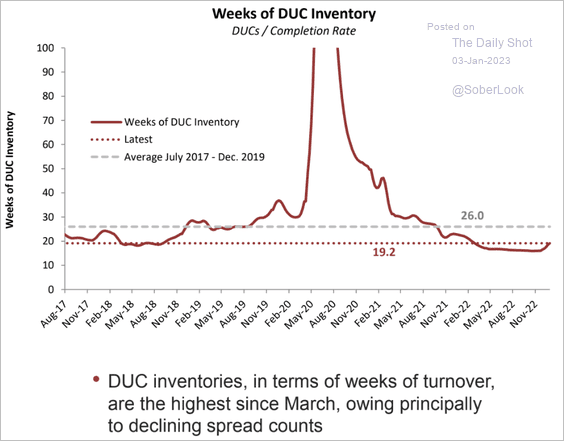 Source: Princeton Energy Advisors
Source: Princeton Energy Advisors
… as fracking activity slowed.
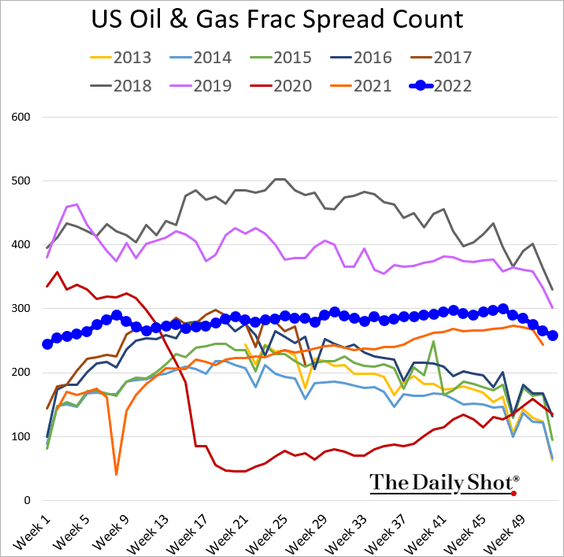
——————–
2. US natural gas continues to tumble, …
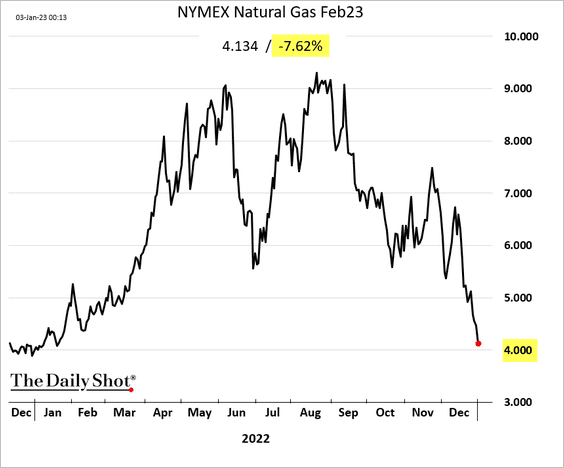
… amid warmer weather.
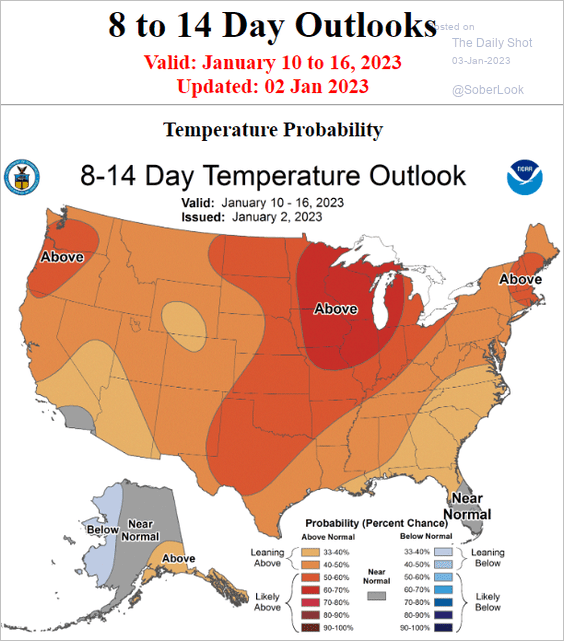 Source: NOAA
Source: NOAA
Back to Index
Equities
1. 2022 saw the largest annual decline for the S&P 500 since 2008.
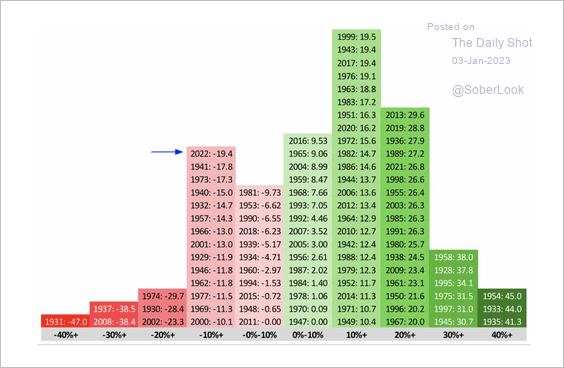 Source: @bespokeinvest
Source: @bespokeinvest
Roughly half of all months in 2022 saw a decline of at least 2.5%.
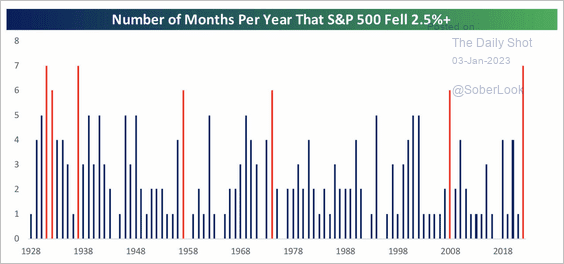 Source: @bespokeinvest
Source: @bespokeinvest
——————–
2. Back-to-back annual losses are rare, but the odds of the bear market continuing remain elevated, according to MarketDesk Research.
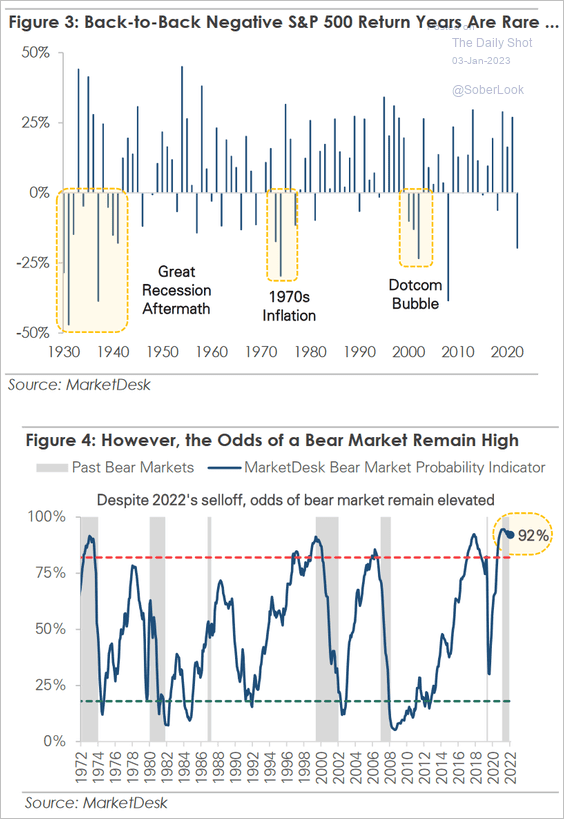 Source: MarketDesk Research
Source: MarketDesk Research
3. S&P 500 duration remains elevated.
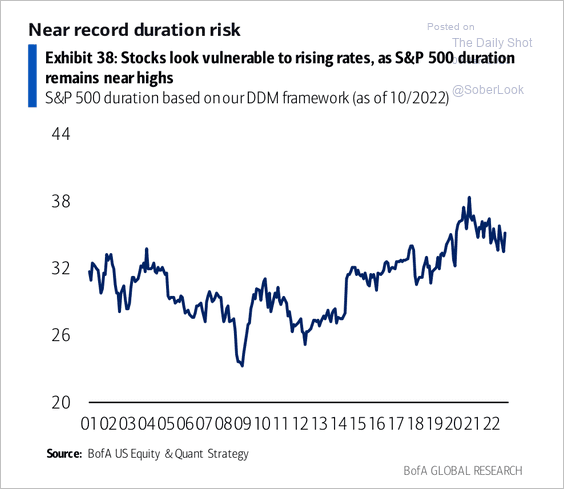 Source: BofA Global Research
Source: BofA Global Research
Roughly 16% of S&P 500 stocks have a dividend yield above 4%, the lowest level in 11 years.
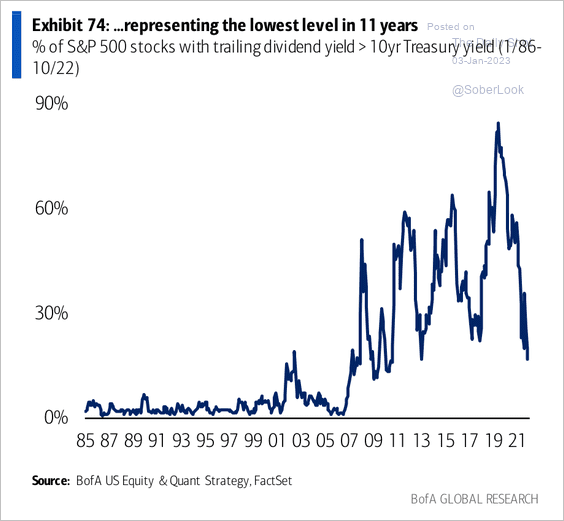 Source: BofA Global Research
Source: BofA Global Research
——————–
4. US equity funds saw net inflows in 2022. The rotation from mutual funds to ETFs continues.
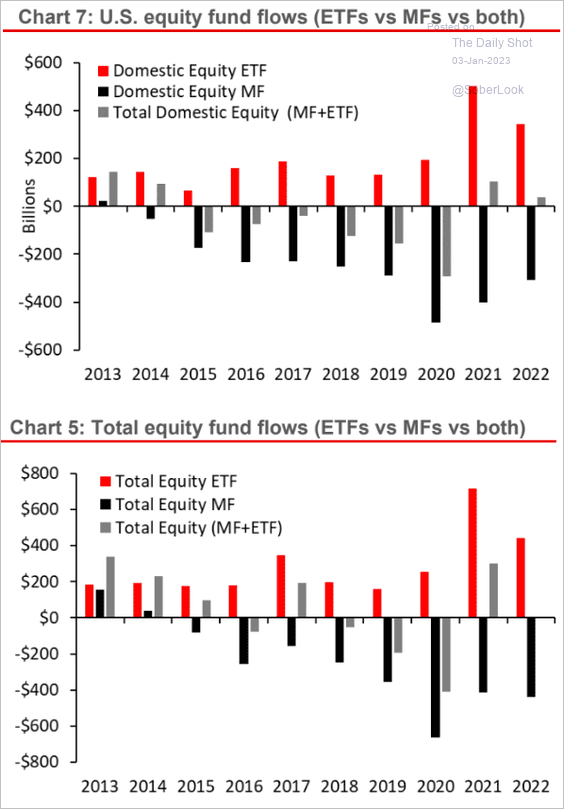 Source: MUFG Securities
Source: MUFG Securities
5. Mutual funds boosted cash holdings last year to manage redemptions.
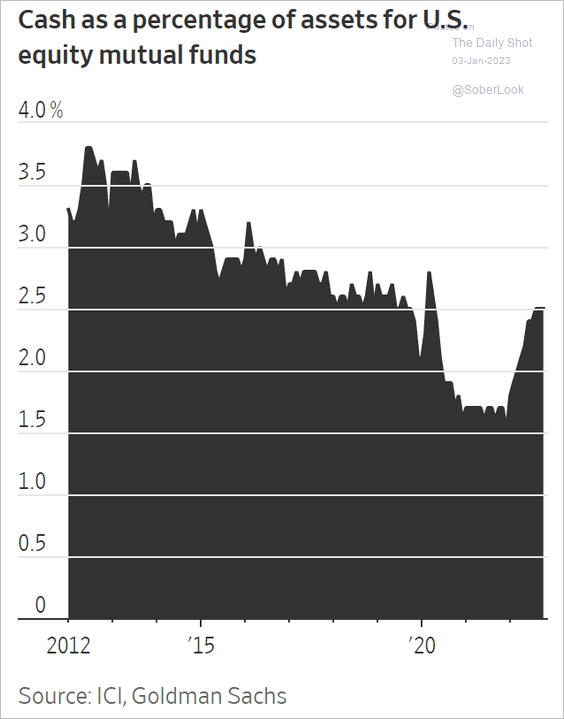 Source: @WSJ Read full article
Source: @WSJ Read full article
6. There is plenty of room for S&P 500 valuation compression, similar to the early 2000s.
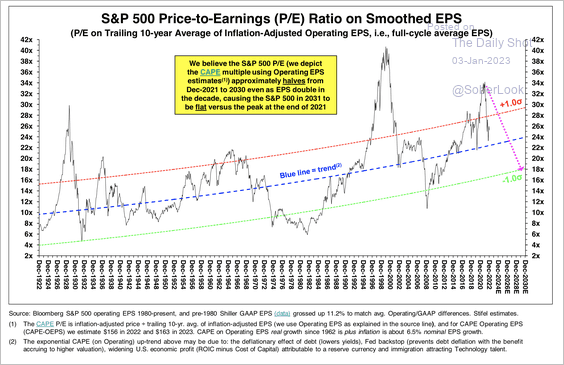 Source: Stifel
Source: Stifel
7. FANG stocks underperformed the S&P 500 by 30% in 2022.
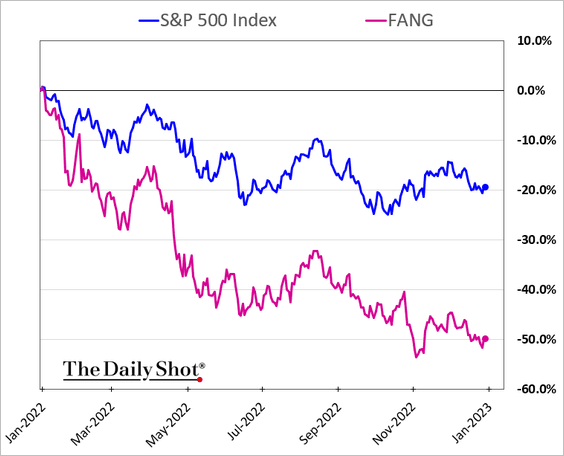
Goldman’s basket of mega-cap tech shares is not far behind.
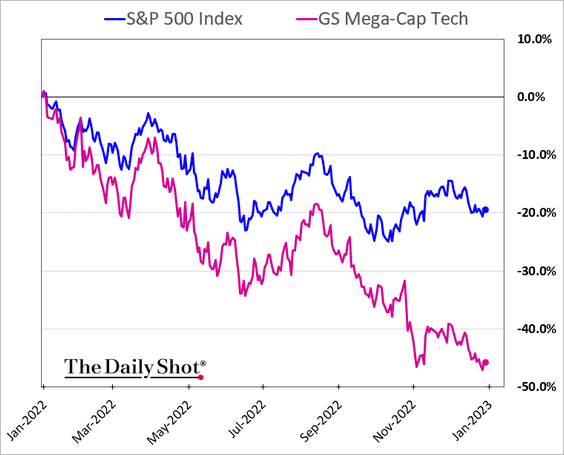
——————–
8. Next, we have some additional performance trends in 2022.
• Short- vs. long-duration shares:
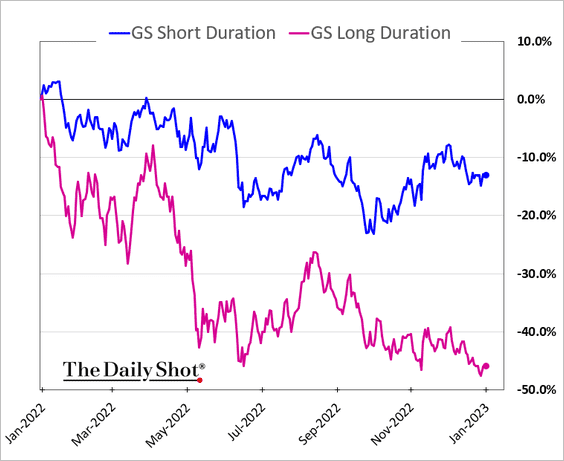
• US companies that are onshoring or have significant onshore presence/supply chains (vs. those with significant offshore production/supply chains):
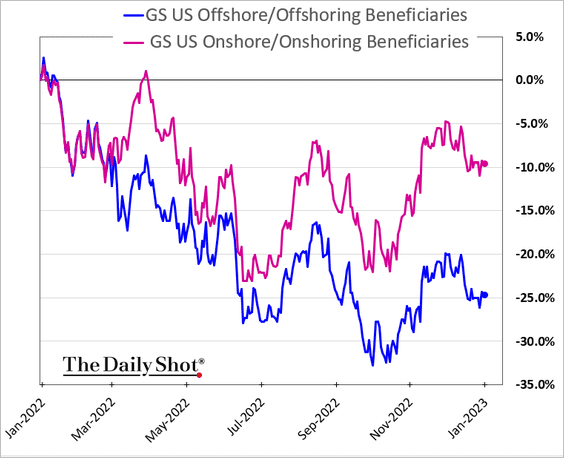
• High vs. low ESG baskets:
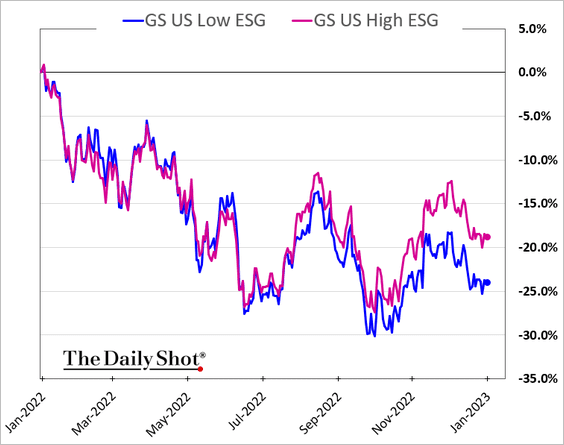
Back to Index
Credit
1. Tighter bank lending standards point to wider HY spreads ahead.
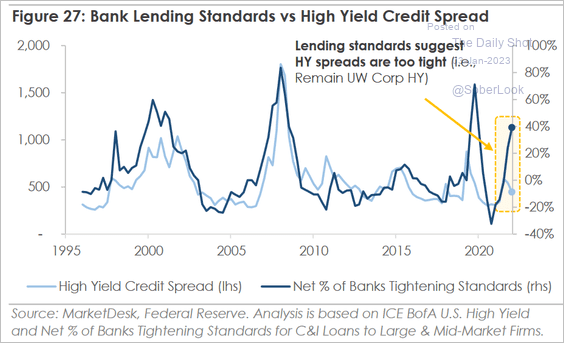 Source: MarketDesk Research
Source: MarketDesk Research
2. Munis have been outperforming Treasuries in recent months.
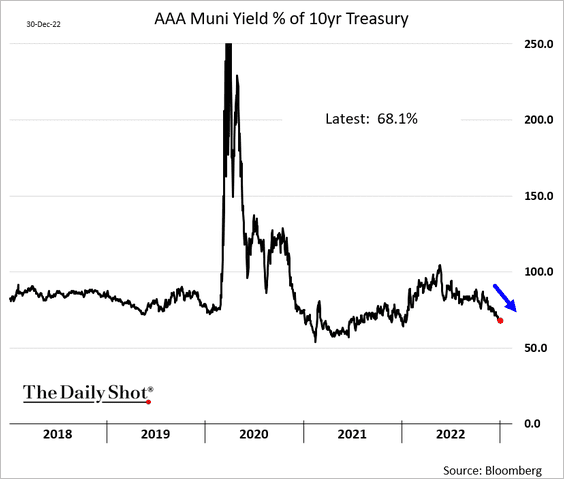
Back to Index
Rates
1. Real yields have been rising, putting pressure on growth stocks.
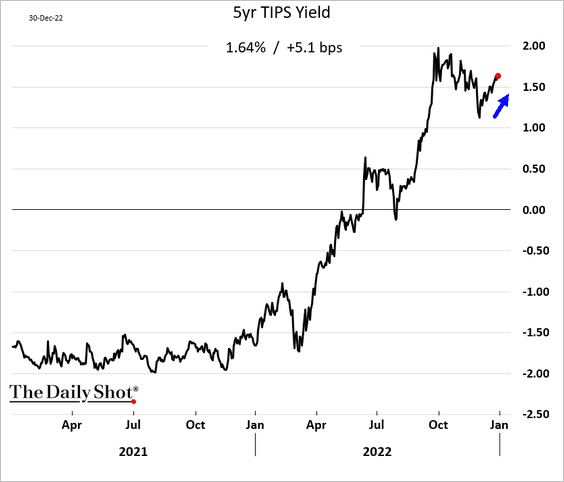
2. Stifel expects the 10-year Treasury yield to reach 6%-7% over the next couple of years, making government borrowing much more expensive. (2 charts)
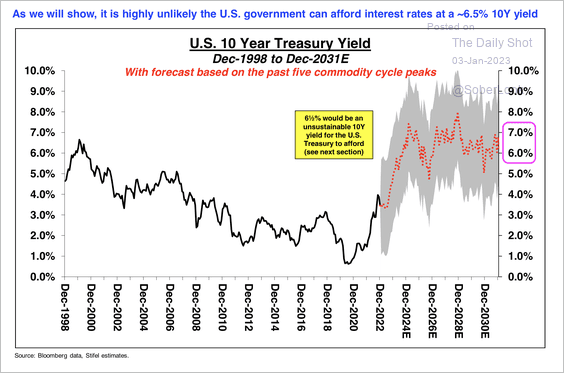 Source: Stifel
Source: Stifel
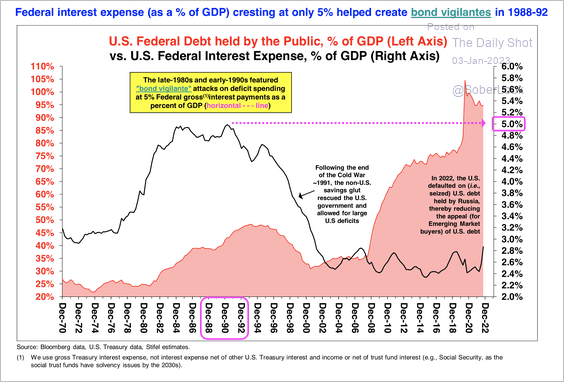 Source: Stifel
Source: Stifel
——————–
3. Treasuries are not attractive to Japanese investors.
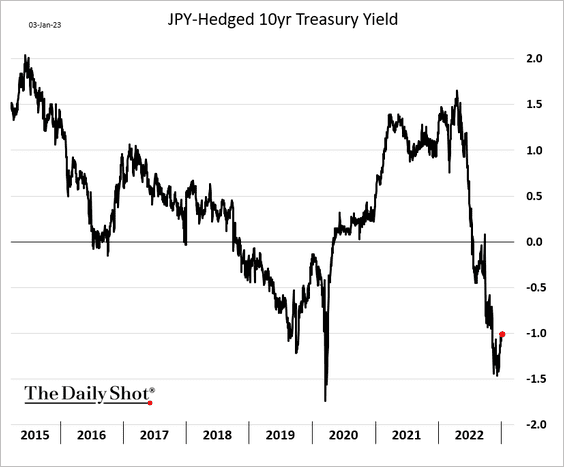
Back to Index
Global Developments
1. M&A activity slowed sharply as 2022 progressed.
 Source: S&P Global Market Intelligence
Source: S&P Global Market Intelligence
2. Sovereign wealth and public pension funds took a hit in 2022.
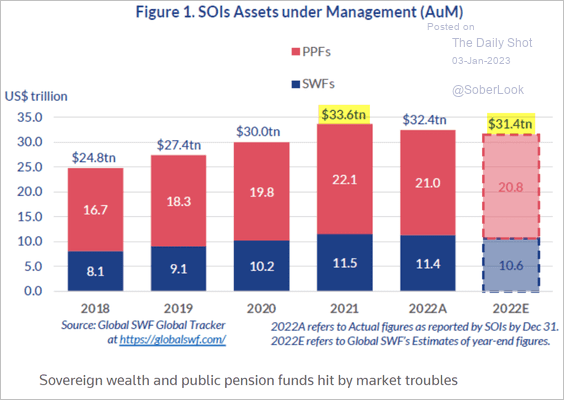 Source: Reuters Read full article
Source: Reuters Read full article
——————–
Food for Thought
1. US public, corporate, and household debt as a share of GDP:
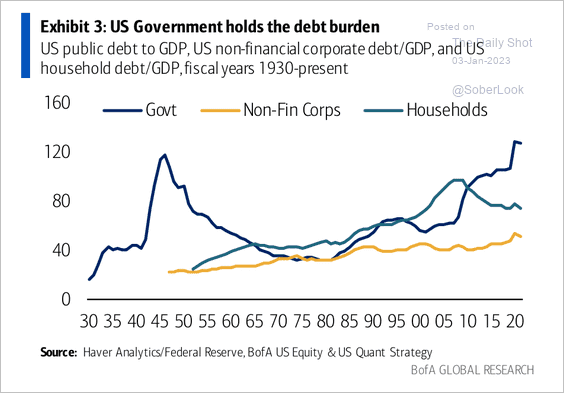 Source: BofA Global Research
Source: BofA Global Research
2. US federal, state, and local revenues and expenditures:
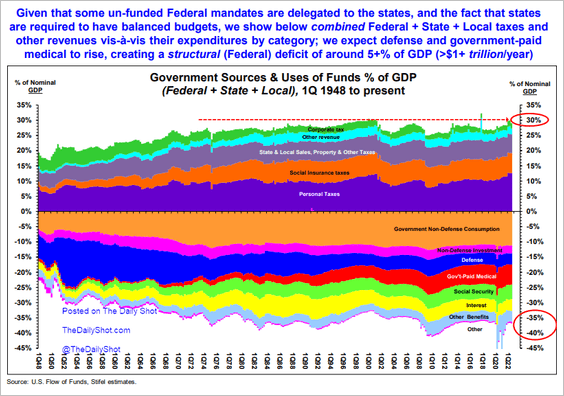 Source: Stifel
Source: Stifel
3. IRS employment:
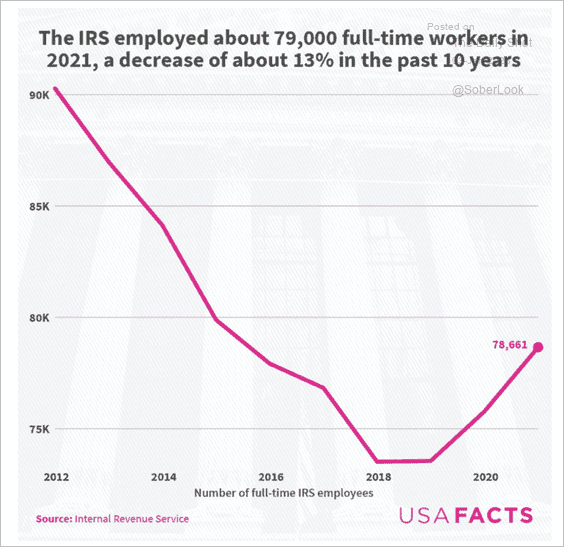 Source: USAFacts
Source: USAFacts
4. Income “redistribution” rates:
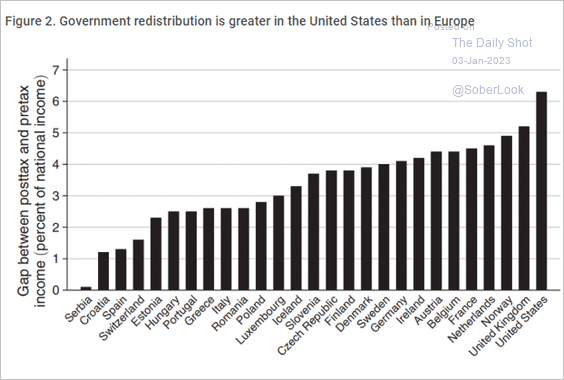 Source: LSE Read full article
Source: LSE Read full article
5. Views on raising the minimum wage:
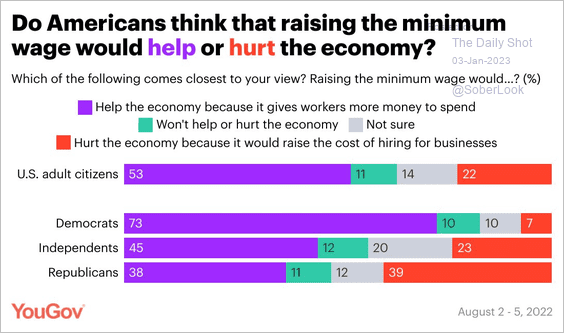 Source: @YouGovAmerica Read full article
Source: @YouGovAmerica Read full article
6. Working-from-home rates by day of the week:
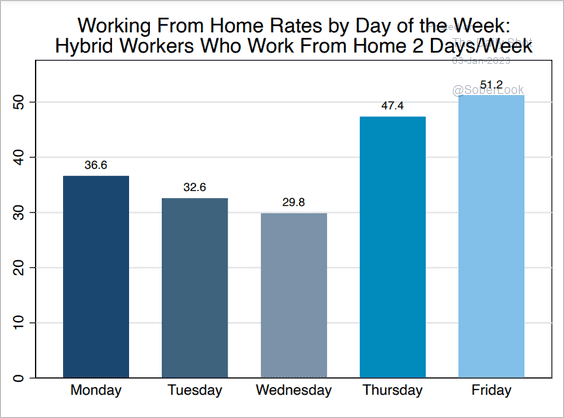 Source: WFH Research Read full article
Source: WFH Research Read full article
7. Remote work and online chess after lockdowns:
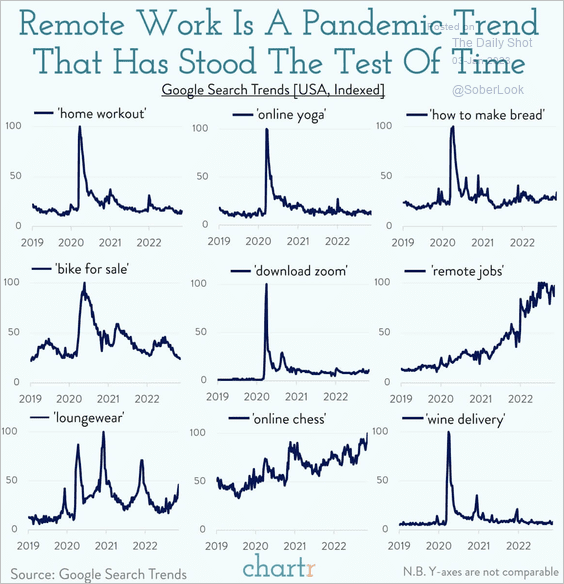 Source: @chartrdaily
Source: @chartrdaily
8. The Trans-African highway master plan:
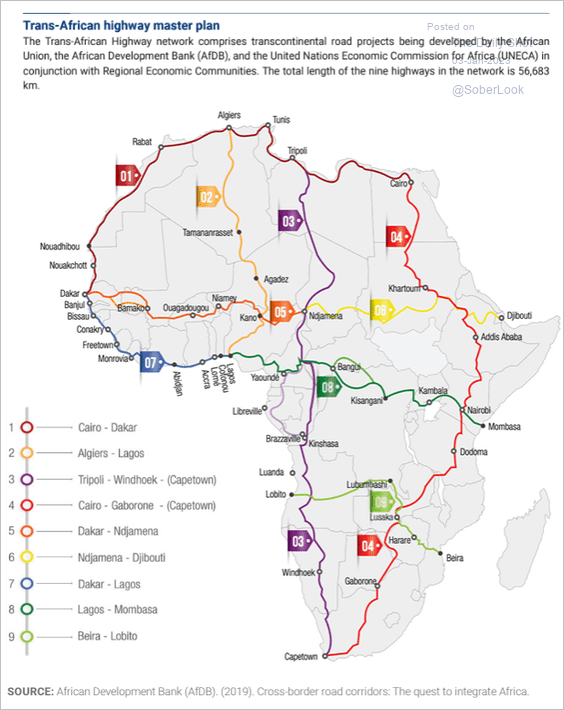 Source: Brookings Read full article
Source: Brookings Read full article
9. Yellow or white light:
 Source: @loverofgeography
Source: @loverofgeography
——————–
Back to Index
